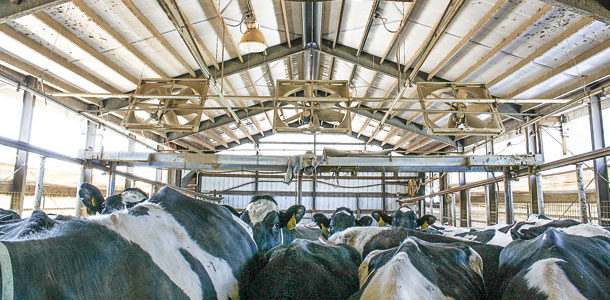When it comes to maintaining milk production during times of heat stress, we often look for the mechanical fix. Fans, sprinklers, misters and other heat abatement systems can certainly be effective tools in minimizing the negative effects of hot temperatures and humid conditions, but the root of the problem is not always something adding another fan is going to solve. Sometimes, a few employee management tweaks are just what you need.
Why were cows struggling?
Such was the case at a 400-cow dairy I consulted a few years back. I was called in to figure out why milk production, reproduction and cow health were struggling on a dairy that seemed to have pretty good protocols and facilities.
Year-round, milk output was in the 70s at best, but that number tanked by 8 to 10 pounds during times of heat stress. In addition, fresh cows were battling their share of retained placentas, metritis and other post-calving disorders, and conception rates couldn’t break out of the mid-20s – even after switching breeders. Of course, these areas didn’t get any better with soaring summertime temperatures.
As on any dairy I consult, I spent the first day observing the workings of the operation. That meant shadowing the cows on their daily journey through the barn to the milking parlor, carefully evaluating each part of their day, from feeding to milking, and looking for the underlying antagonists that could be holding them back from realizing their potential.
I noted that the cows looked comfortable in their stalls, and they were receiving good-quality feed at the bunk. The heat abatement system, which included a combination of fans and sprinklers, was functioning effectively in the barn. Overall cow handling and milking technique was satisfactory.
However, I saw the red flag as I followed the cows through the holding pen. They were held in this stuffy, uncooled area for what seemed like forever. In fact, between the three milkings, this is where the cows were spending a total of six hours – one quarter of their day.
Now their struggles made sense. Each minute the cows were in the holding pen was time they could have been bellied up to the feedbunk eating or relaxing under a fan in a stall.
Short-changing bunk time was resulting in cows that were thin at dry-off and unable to rebound after freshening. Add to that reduced intakes, compounded by heat stress and excess standing, and we had a recipe for milk production loss. Naturally, reproduction also lagged as a result of these factors.
A hold-up in the holding pen
My next step was to figure out why cows were in the holding pen for such a significant portion of their day. They were being milked in a double-16 parlor, which was oversized in proportion to the herd size. But there was more to it than just that.
As I dug deeper, I began to scratch the surface of what was really going on. The milkers were in no hurry to move cows through. Because they were paid by the hour, parlor efficiency was not a priority; thus, the employees were stretching out both the time in the parlor and the waiting time in the holding pen twice as long as needed.
Did this mean the dairy had bad employees? Not necessarily. The given management structure motivated them to make more money by taking longer to do their job.
More milkings with less labor
Knowing this, I strategically made schedule changes and moved employees around. I put the best employees in the parlor for two 10-hour shifts each day, leaving only two hours of parlor downtime. By paying them by the shift, the incentive was now to finish the task at hand, not to drag it out.
I also added a milking, so the entire herd would come through the parlor four times a day, or twice per shift, without adding any more labor. In fact, with this re-organization, overall labor costs were actually reduced and a few part-time employees were let go.
As for the cows, even with the extra pass through the parlor, they were now spending two hours a day less in the holding pen, and more time in the barn where they could eat, be cooled, rest and make milk.
Milk production increased by 12 pounds per cow and is now better maintained through times of heat stress. With feed intakes up, the herd’s conception rate improved to 29 percent and there are fewer fresh cow issues.
Overall, the cow management was good on this dairy; it was the people management that was the problem. So as you plan for heat abatement on your dairy, remember that it is not always something a fan can fix. PD
Pauly Paul is a dairy management consultant with Roach & Associates LLC. He can be contacted by email.
PHOTO
With a few employee management tweaks, cows were spending less time in the holding area and more time at the feedbunk or resting in their stalls. Photo by Peggy Coffeen.






